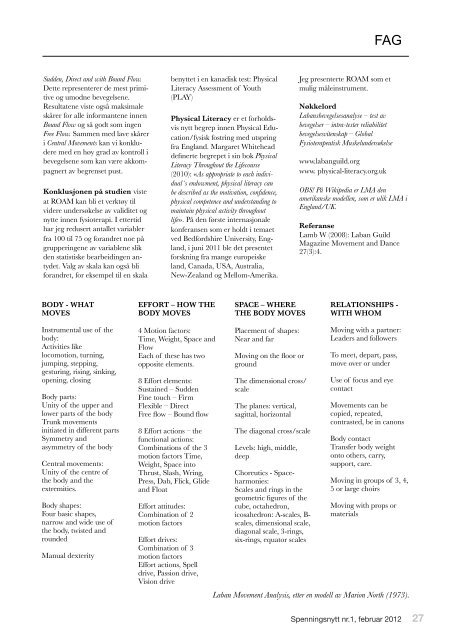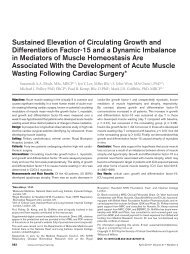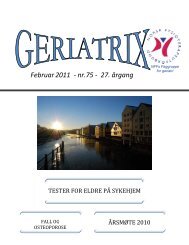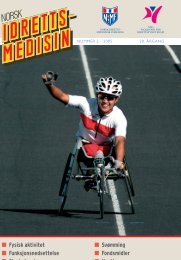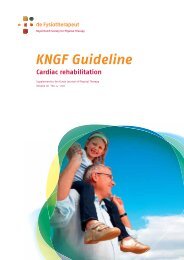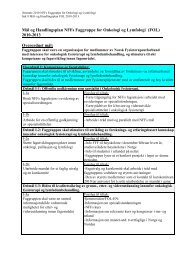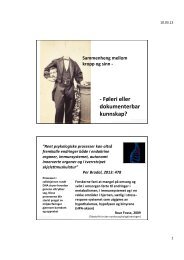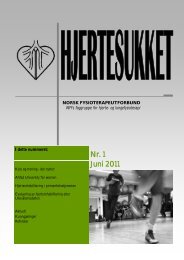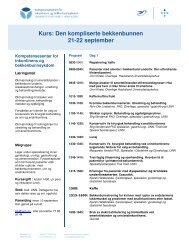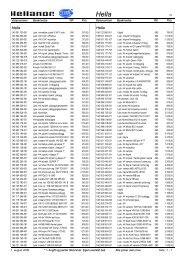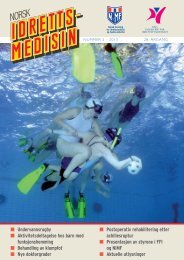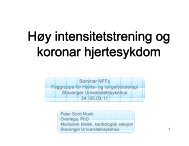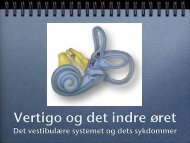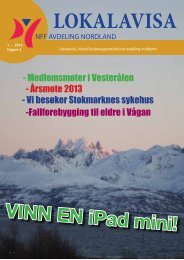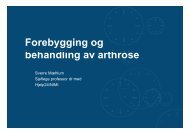februar 2012.pdf
februar 2012.pdf
februar 2012.pdf
- No tags were found...
Create successful ePaper yourself
Turn your PDF publications into a flip-book with our unique Google optimized e-Paper software.
FAG<br />
Sudden, Direct and with Bound Flow.<br />
Dette representerer de mest primitive<br />
og umodne bevegelsene.<br />
Resultatene viste også maksimale<br />
skårer for alle informantene innen<br />
Bound Flow og så godt som ingen<br />
Free Flow. Sammen med lave skårer<br />
i Central Movements kan vi konkludere<br />
med en høy grad av kontroll i<br />
bevegelsene som kan være akkompagnert<br />
av begrenset pust.<br />
Konklusjonen på studien viste<br />
at ROAM kan bli et verktøy til<br />
videre undersøkelse av validitet og<br />
nytte innen fysioterapi. I ettertid<br />
har jeg redusert antallet variabler<br />
fra 100 til 75 og forandret noe på<br />
grupperingene av variablene slik<br />
den statistiske bearbeidingen antydet.<br />
Valg av skala kan også bli<br />
forandret, for eksempel til en skala<br />
benyttet i en kanadisk test: Physical<br />
Literacy Assessment of Youth<br />
(PLAY)<br />
Physical Literacy er et forholdsvis<br />
nytt begrep innen Physical Education/fysisk<br />
fostring med utspring<br />
fra England. Margaret Whitehead<br />
definerte begrepet i sin bok Physical<br />
Literacy Throughout the Lifecourse<br />
(2010): «As appropriate to each individual´s<br />
endowment, physical literacy can<br />
be described as the motivation, confidence,<br />
physical competence and understanding to<br />
maintain physical activity throughout<br />
life». På den første internasjonale<br />
konferansen som er holdt i temaet<br />
ved Bedfordshire University, England,<br />
i juni 2011 ble det presentet<br />
forskning fra mange europeiske<br />
land, Canada, USA, Australia,<br />
New-Zealand og Mellom-Amerika.<br />
Jeg presenterte ROAM som et<br />
mulig måleinstrument.<br />
Nøkkelord<br />
Labansbevegelsesanalyse – test av<br />
bevegelser – intra-tester reliabilitet<br />
bevegelsesvitenskap – Global<br />
Fysioterapeutisk Muskelundersøkelse<br />
www.labanguild.org<br />
www. physical-literacy.org.uk<br />
OBS! På Wikipedia er LMA den<br />
amerikanske modellen, som er ulik LMA i<br />
England/UK.<br />
Referanse<br />
Lamb W (2008): Laban Guild<br />
Magazine Movement and Dance<br />
27(3):4.<br />
BODY - WHAT<br />
MOVES<br />
EFFORT – HOW THE<br />
BODY MOVES<br />
SPACE – WHERE<br />
THE BODY MOVES<br />
RELATIONSHIPS -<br />
WITH WHOM<br />
Instrumental use of the<br />
body:<br />
Activities like<br />
locomotion, turning,<br />
jumping, stepping,<br />
gesturing, rising, sinking,<br />
opening, closing<br />
Body parts:<br />
Unity of the upper and<br />
lower parts of the body<br />
Trunk movements<br />
initiated in different parts<br />
Symmetry and<br />
asymmetry of the body<br />
Central movements:<br />
Unity of the centre of<br />
the body and the<br />
extremities.<br />
Body shapes:<br />
Four basic shapes,<br />
narrow and wide use of<br />
the body, twisted and<br />
rounded<br />
Manual dexterity<br />
4 Motion factors:<br />
Time, Weight, Space and<br />
Flow<br />
Each of these has two<br />
opposite elements.<br />
8 Effort elements:<br />
Sustained – Sudden<br />
Fine touch – Firm<br />
Flexible – Direct<br />
Free flow – Bound flow<br />
8 Effort actions – the<br />
functional actions:<br />
Combinations of the 3<br />
motion factors Time,<br />
Weight, Space into<br />
Thrust, Slash, Wring,<br />
Press, Dab, Flick, Glide<br />
and Float<br />
Effort attitudes:<br />
Combination of 2<br />
motion factors<br />
Effort drives:<br />
Combination of 3<br />
motion factors<br />
Effort actions, Spell<br />
drive, Passion drive,<br />
Vision drive<br />
Placement of shapes:<br />
Near and far<br />
Moving on the floor or<br />
ground<br />
The dimensional cross/<br />
scale<br />
The planes: vertical,<br />
sagittal, horizontal<br />
The diagonal cross/scale<br />
Levels: high, middle,<br />
deep<br />
Choreutics - Spaceharmonies:<br />
Scales and rings in the<br />
geometric figures of the<br />
cube, octahedron,<br />
icosahedron: A-scales, B-<br />
scales, dimensional scale,<br />
diagonal scale, 3-rings,<br />
six-rings, equator scales<br />
Moving with a partner:<br />
Leaders and followers<br />
To meet, depart, pass,<br />
move over or under<br />
Use of focus and eye<br />
contact<br />
Movements can be<br />
copied, repeated,<br />
contrasted, be in canons<br />
Body contact<br />
Transfer body weight<br />
onto others, carry,<br />
support, care.<br />
Moving in groups of 3, 4,<br />
5 or large choirs<br />
Moving with props or<br />
materials<br />
Laban Movement Analysis, etter en modell av Marion North (1973).<br />
Spenningsnytt nr.1, <strong>februar</strong> 2012 27


